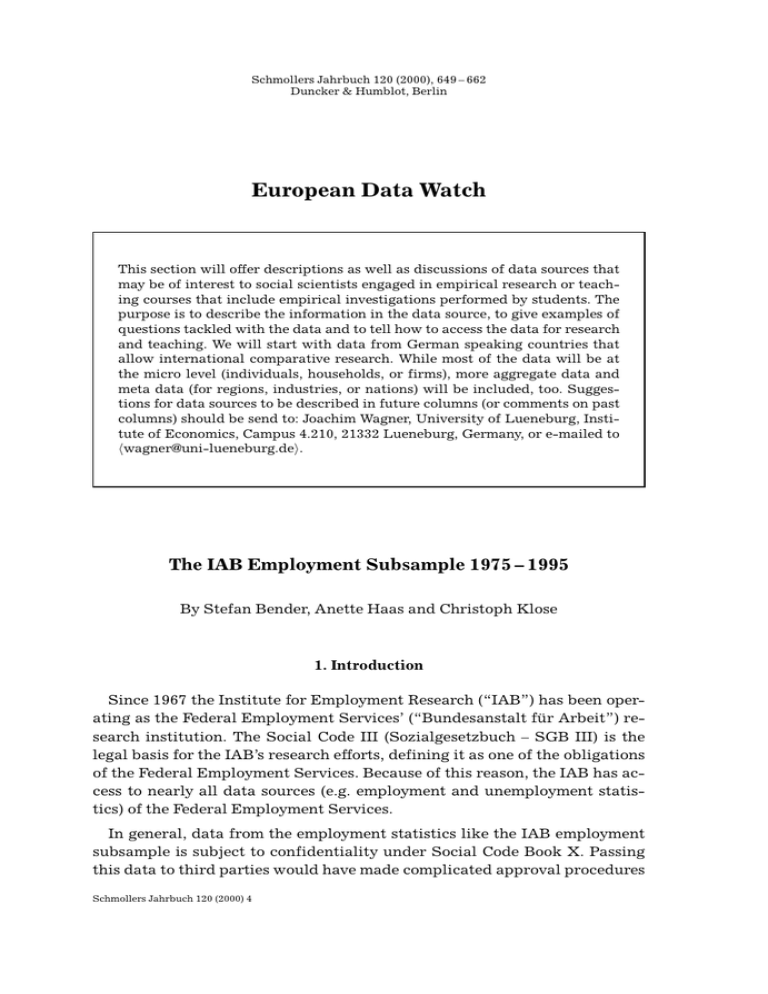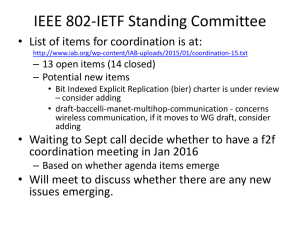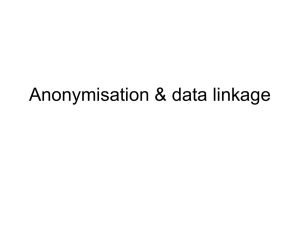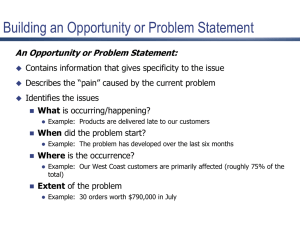The IAB Employment Subsample 1975-1995
advertisement

Schmollers Jahrbuch 120 (2000), 649 ± 662 Duncker & Humblot, Berlin European Data Watch This section will offer descriptions as well as discussions of data sources that may be of interest to social scientists engaged in empirical research or teaching courses that include empirical investigations performed by students. The purpose is to describe the information in the data source, to give examples of questions tackled with the data and to tell how to access the data for research and teaching. We will start with data from German speaking countries that allow international comparative research. While most of the data will be at the micro level (individuals, households, or firms), more aggregate data and meta data (for regions, industries, or nations) will be included, too. Suggestions for data sources to be described in future columns (or comments on past columns) should be send to: Joachim Wagner, University of Lueneburg, Institute of Economics, Campus 4.210, 21332 Lueneburg, Germany, or e-mailed to hwagner@uni-lueneburg.dei. The IAB Employment Subsample 1975 ± 1995 By Stefan Bender, Anette Haas and Christoph Klose 1. Introduction Since 1967 the Institute for Employment Research (ªIABº) has been operating as the Federal Employment Services' (ªBundesanstalt fuÈr Arbeitº) research institution. The Social Code III (Sozialgesetzbuch ± SGB III) is the legal basis for the IAB's research efforts, defining it as one of the obligations of the Federal Employment Services. Because of this reason, the IAB has access to nearly all data sources (e.g. employment and unemployment statistics) of the Federal Employment Services. In general, data from the employment statistics like the IAB employment subsample is subject to confidentiality under Social Code Book X. Passing this data to third parties would have made complicated approval procedures Schmollers Jahrbuch 120 (2000) 4 650 Stefan Bender, Anette Haas and Christoph Klose necessary. To avoid such difficulties the IAB decided on the anonymisation of the data with a procedure based on the factual anonymisation under the Federal Statistics Act. The project could only be realized with financial assistance from the scientific community. Along with the anonymising of person- and establishment-related cross-section information, the longitudinal information of the persons involved had to be anonymised factually, too. The procedure mainly consisted in the aggregation of the characteristics and in a shift of the complete employment history of each person on the time axis. The anonymised IAB employment subsample is now available for researchers in a third, anonymised version. Following the so-called basic file and the regional file from the IAB employment subsample, which encompassed the years 1975 to 1990, the actualized version of the basic file covers now the years 1975 to 1995 and contains for the first time information on Eastern Germany for the period 1992 to 1995. Therefore, the IAB employment subsample is equipped with data of one percent of all employees registered by the social insurance system within the given period of 21 years. It contains exact daily flow information on the employment history of 559,540 persons as recorded by the social insurance system and on periods of drawing benefits as well. It allows reproducing employment careers without typical problems of longitudinal surveys which do arise in social research (e.g. panel mortality, memory gaps). Nevertheless there are specific problems which appear as a result of the data generation process. The anonymised IAB employment subsample which is available to researchers through the Central Archive for Empirical Social Research at the University of Cologne is, one of the most important German sources for employment market research (Alba et al. 1994). First of all, we will give a short overview of the data generating process and the data characteristics. A discussion of the variables and the anonymisation procedures are given (chapter 3). A brief discussion of data access (chapter 4) will follow and with a conclusion the article ends. 2. The IAB employment subsample ± data characteristics The basis of the IAB employment subsample1 is the integrated notifying procedure for health insurance, statutory pension scheme and unemployment insurance which was introduced in West-Germany with effect from 1 January 1973. Since 1. 1. 1991, the notifying procedure has also been ap1 A detailed representation of the IAB employment subsample can be found in Bender et al. (1996, 1999, 2000a). Schmollers Jahrbuch 120 (2000) 4 The IAB Employment Subsample 1975 ± 1995 651 plied to Eastern Germany. The procedure requires that employers report all information of their employees registered by the social security system to the social security agencies. This data has been stored into files, the socalled employment statistics ± by the Federal Employment Service (Bundesanstalt fuÈr Arbeit) to provide an insurance account for each employee recorded by the German social insurance system. There are different data sets in the Federal Employment Services, which are summarized under the name employment statistics. It is the current file, the quarterly files (31.3, 30.6, 30.9 and 31.12), the annual period material and the historic file. The historic file is the source for the IAB employment subsample and contains information on employment covered by social insurance which has been passed from social insurance agencies to the Federal Employment Service since the notifying procedure was introduced in 1973. The history file is generated from the employment statistics by storing the notifications submitted in previous years through the notifying procedure in archive storage media at the end of a year in accordance with a defined algorithm. So there are all notifications inside since the introduction of the notifying procedure. ªAll that has been published so far out of this enormous body of data is in a highly aggregated form: tables of averages by industrial sectors and regions, which are published quarterly, annually, and for longer periods.º (Alba et al. 1994: 66). The informative value of the employment statistics depends essentially on the respective definition of employment covered by social security. It should also be taken into consideration that the person providing the information might change during the time, e.g. because of interfirm mobility. This can also lead to implausible information in the employment history (e.g. change of training or nationality). The employment statistics include workers, salaried employees and all trainees, as long as they are not exempt from the obligation to pay social insurance contributions. The employment statistics do not include, among others, civil servants, those in marginal employment, students enrolled in higher education and family workers. For 1995, the employment statistics cover nearly 79.4% of all employed persons in Western Germany, and 86.2% of all employed persons in Eastern Germany,2 but the coverage varies over individual occupations and industries. Furthermore, in empirical analyses, it has to be noted that the definition of variables (e.g. wage) may have changed during the past years. Notifications are prescribed for the beginning and ending of employment, also apprenticeship since 1992. In addition, an annual report must be made 2 Calculated on the basis of employed persons (domestic concept) from the Statistisches Bundesamt, Wirtschaft und Statistik 12 / 1997. Schmollers Jahrbuch 120 (2000) 4 652 Stefan Bender, Anette Haas and Christoph Klose for each employee covered by social insurance who is employed on the 31 December of the year. These yearly notifications have the function of stocktaking, because the notifying procedure is conceived in such a way that employment must be confirmed in the course of time without any gaps, or concluded by means of a cancellation. This means that for each employment there is a notification, an annual report in case the employment continues over the end of the year, and a cancellation or termination of the employment, all within statutorily prescribed periods. The characteristics sex, year of birth, nationality, marital status, number of children and qualifications, are collected for each employee recorded by social insurance. Exact daily data on employment contains information on the occupational code, the occupational status, the gross earnings to the contribution assessment ceiling, an establishment number issued by the Employment Service, the industry and the size of the establishment.3 The available characteristics can be divided into two categories. On the one hand, some characteristics (insurance numbers, employment duration and earnings covered by social insurance contributions) mainly serve insurance law purposes. These must be notified with each interfirm change, and are, therefore, very accurate. On the other hand, the IAB employment subsample contains characteristics with purely statistical information. Changes to these characteristics are notified at the end of the year with the annual report (Cramer 1985). A systematic 1-% sample was taken from the historic file. This sample covers a period of 21 years for Western Germany (1. 1. 1975 to 31. 12. 1995) and 4 years for eastern Germany (1. 1. 1992 to 31. 12. 1995). The sample's total population consists of all employment cases in occupations covered by social insurance at least once between 1975 and 1995. In the annual averages, the IAB employment subsample includes about 200,000 persons in Western Germany, 52,000 persons in Eastern Germany. It contains exactly a total of 7,847,553 notifications; 559,540 persons from Western Germany, and 354,091 from Eastern Germany, accumulate 6,711,153 notifications. On the basis of the final notification in each case, the file contains 483,327 Western Germans and 76,213 Eastern Germans. This database is supplemented by data on benefits recipients and by establishment information: (1) The benefits recipients file contains person-related information on periods in which the Federal Employment Service paid benefits. These periods are periods in which persons draw substitute wage payments from the Federal Employment Service, such as unemployment benefit, unem3 Regional characteristics are also collected, but these cannot be passed on to users for reasons of data confidentiality. Schmollers Jahrbuch 120 (2000) 4 The IAB Employment Subsample 1975 ± 1995 653 ployment assistance or maintenance payments for advanced vocational training or retraining. This does not cover all possible periods of unemployment. Unless specific preconditions are fulfilled a claimant may draw unemployment benefit [so-called ªprimaryº unemployment assistance (ªoriginaÈreº Arbeitslosenhilfe)]. Unemployment assistance is only paid in the case of personal need. In addition, the file does not record all benefits paid by the Federal Employment Service to persons (cf. Bender et al. 1996: 26). (2) The establishment file contains information on establishments, which are notifying, or have notified, employment covered by social insurance. The Federal Employment Service keeps a file containing all establishment numbers, which the Employment Offices have ever issued to establishments providing employment. When an establishment number is issued, an attempt is made to keep to the concept of the workplace, but this is not carried out on a uniform basis. The establishment characteristic is supplemented by information on the notifying establishments which, like the historic file, is ascertained from the employment statistics collected by the Federal Employment Office. In contrast to the historic file, existing notifications are not simply filed. Additional information on the establishments is generated from the employment notifications submitted by establishments, because the establishment number provides an unambiguous key characteristic for identifying establishments. Using the employment statistics4 as a basis, aggregations of the person-related attributes on school and vocational training are carried out in accordance with the establishment characteristic, particularly establishment-related employment figures have been determined on 30 June each year since 1977. However, the proportion of employees covered by social insurance among all employees depends on the industry. For example, a very high degree of coverage can be assumed for manufacturing industry and a low degree of coverage (up to 50%) in the services industry (cf. Bender et al. 1996). The compressed file, which has 659,221,308 Bytes decompressed, and 131,831,566 Bytes in a compressed format, does not have to be decompressed if the user decides to use the statistic software TDA (Transition Data Analysis; c.f. Rohwer / PoÈtter 2000). TDA is available in the Internet via ftp://stat.ruhr-uni-bochum.de/pub / tda (WWW address: http://www.stat. ruhr-uni-bochum.de). 4 The notification procedure can be regarded as a continuous complete population survey of employees covered by social insurance. Schmollers Jahrbuch 120 (2000) 4 654 Stefan Bender, Anette Haas and Christoph Klose 3. Information in the data ± The anonymisation of the IAB employment subsample The data contained in the employment statistics is social data, and is, therefore, subject to confidentiality according to § 35 of the Social Code, Book I. For this reason, the IAB decided on anonymisation; it has kept to factual anonymisation under § 16 (6) of the Federal Statistics Act, and has also used to a great extent the methods applied during the anonymisation of the German microcensus (MuÈller et al. 1991, 1995). There is a so called cross-sectional and a longitudinal anonymisation. The cross-sectional information of the variables will be given below, but first a description of the main concept of the longitudinal anonymisation will be given. The aim of anonymisation of the longitudinal information is to make it at least more difficult to date notifiable events exactly. The daily accuracy results directly from the tasks of the notification procedure (e.g. calculating pension rights). In order to prevent changes to the arrangement of events with one another with regard to time and to the duration of episodes, the complete employment history for each employee (all periods of employment and of drawing benefits) was shifted along the time axis by a constant amount to anonymise the longitudinal information. The individual shift constant for the complete employment biography of an individual was stipulated by drawing an independent identical normal distributed random variable with the expectation value zero. Anonymisation of the longitudinal information causes problems for crosssection analyses, which are linked to defined historical periods. However, if massive effects are linked to the key date, for example seasonal effects on unemployment in certain industries, this effect will be smudged with time through the anonymisation and will appear less concise the greater the variance of the random shift is. Coming to the cross-sectional anonymisation for persons, it can be seen that a large part of the person-related cross-section information can be passed in the original state, or with only slight modifications. In the following, the central, person-related characteristics and their modifications resulting from the rules for anonymisation will be shown: The insurance number was replaced by a system-free personal number. A person's sex is a component of the insurance number. This characteristic was not anonymised. The year of birth is also a component of the insurance number. Anonymisation was carried out at each end of the age distribution only. Because this Schmollers Jahrbuch 120 (2000) 4 The IAB Employment Subsample 1975 ± 1995 655 characteristic is time-constant, the first, and the last, notification for a person was included to assess an anonymisation. Persons under 16 (on the first notification), or over 66 (on the last notification) in Western Germany, or 63 in Eastern Germany, were each included in one category. Marital status differentiates between ªmarriedº and ªsingleº, and is also found in the original status in the anonymised sample. Number of children: the input of the number of children is based on the information on the tax cards and is available as a continuous characteristic. The characteristic is shown in the original up to seven children; from eight children, the category is ªeight and more childrenº. With regard to nationality it must be stated that the definition of who is a German is found in Art. 116 (1) of the Basic Law. Coding is carried out in accordance with the personal systematics ± nationality and area code of the Federal Office of Statistics. 188 nationalities are altogether found in the IAB employment subsample, nine nationalities and seven nationality groups are shown for Western Germany. Because of the extremely low numbers of non-Germans in Eastern Germany, the only differentiation possible here is between Germans and other nationalities. Education represents the achieved schooling and concluded vocational training in eight categories. The schooling categories ªlower and middle secondary schoolº and ªupper secondary school leaving certificate (university entrance level) are subdivided into the education categories ªno vocational trainingº and ªcompleted vocational trainingº. In addition, there are categories for ªcompleted non-university higher educationº, ªuniversity degreeº, ªeducation not knownº and ªmissingº. Anonymisation procedures were not carried out. The occupational code refers directly to the job contents. Allocation in this category is carried out in accordance with the code list from the Federal Employment Service (1975) with a three-digit code. Of the 334 occupations, 234 are retained in their original classification for Western Germany; the remaining 100 were reclassified to form 41 occupational groups. In the case of Eastern Germany, 111 occupations can still be passed on in their original classification; the remaining 224 were aggregated to form 81 occupational groups. The employment status differentiates for those in full-time employment between ªapprentice, trainee, student traineeº, ªunskilled workerº, ªskilled workerº, ªmaster craftsman, foremanº, ªsalaried employeeº and ªoutworkerº. In addition, a differentiation is made between two groups of part-time employees in accordance with the ratio between contractually agreed and the usual working hours in an establishment; there is no inforSchmollers Jahrbuch 120 (2000) 4 656 Stefan Bender, Anette Haas and Christoph Klose mation for these groups regarding their employment status. It was possible to adopt this characteristic without any anonymisation measures. The gross pay subject to social insurance contributions is given for each notification at the end of an employment period and in each annual report. The upper limit is the contribution assessment ceiling for pensions insurance, which is adapted annually to the developments in wages and salaries, and the lower limit is the pay limit for those in marginal employment. A daily income was calculated from the wages sum for a notification period and this is found in an exact sum in DM between the contribution assessment ceilings. In contrast to the older version of the IAB employment subsample, the pay is no longer rounded, but is shown truncated to the respective daily income. There was a change in the definition of income in 1984, so the researcher has to keep this in mind for longitudinal analysis (Steiner / Wagner 1997). The benefits recipients file is used to form the three statements 1. unemployment benefit and comparable benefits (e.g. unemployment allowances, settling-in allowances for the unemployed, severance payments), 2. unemployment assistance and comparable benefits (e.g. unemployment assistance for members of the armed forces on short-term contracts), and 3. maintenance allowances and comparable benefits (e.g. settling-in allowances on further training / retraining, or for German language courses) from over 60 different types of benefit. This large number of benefit types arises from a series of procedural changes, which have their basis in amendments to the Employment Promotion Act (ªArbeitsfoÈrderungsgesetzº). There is still a lack of usable, practical systematic knowledge regarding the anonymisation of establishments (cf. Brand et al. 1999). However, it is still assumed that the risk of re-identification, and the benefit of de-anonymisation, increases with the size of an establishment. Establishment characteristics and changes to them arising from the anonymisation rules are briefly shown below: The Employment Offices issue the establishment number to employers. It is replaced by a system-free establishment number. The industry is assigned to a three-digit code of the establishment number and is in accordance with the list of industries used for the statistics of the Federal Employment Service (1973 edition). To protect anonymity, this code is usually shown as two digits; however, the specific nature of the information depends on the size of the establishment and on the differentiation Eastern / Western Germany. Schmollers Jahrbuch 120 (2000) 4 The IAB Employment Subsample 1975 ± 1995 657 The establishment size is calculated on the basis of the establishment number from the quarterly file of the employment statistics (30.6) as a continuous variable, only refering to the employees covered by the social insurance system under an establishment number. In the anonymised file there are eight (Western Germany) and seven (Eastern Germany) establishment size classes and a missing category. Special rules apply to establishments, which change their size over time, and to clearly identifiable establishments. The establishment's first and last notification year is supplied from the IAB's establishment file. This file is available for the years 1977 to 1995. This means that a difference can be made between voluntary and involuntary firm mobility. Three proportion values are formed from the aggregation of establishment numbers in the establishment file. These are: the proportion of employees covered by social insurance with university-equivalent qualifications or university degrees, the proportion of employees covered by social insurance who have completed vocational training, and the proportion of employees covered by social insurance who have not completed vocational training. This information is given in integer percentage values. 4. Data access Since August 1999 the IAB employment subsample is available to researchers through the Central Archive for Empirical Social Research at the University of Cologne (abbreviated throughout as ªZAº) is available under the ZA number 3136. Users have to pay the standard ZA fees when ordering a data file, which is according to user status between 10 to 300 DM (http:// www.za.uni-koeln.de/order/en/data-sets/gebuehren.htm). Since then, the ZA has supplied the file to about 50 institutions (all versions). A series of papers based on the IAB employment subsample have also been published. Some examples, and this is not a full list, are in the appendix. The anonymisation of this file was realized in the context of the research project ªSplitting or exclusion? Employment market segmentations and fluctuations in Eastern and Western Germanyº, conducted by Professor Dr. Peter A. Berger, Chair of Macro-Sociology (University of Rostock) and cofinanced by the German Research Association (DFG)5. At present, anonymisation of a new regional file is being carried out (project title ªRegional adjustment processes in the Federal Republic of Germany with particular con5 DFG is the central public funding organisation for academic research in Germany. DFG is thus comparable to a Research Council (in British and Western European terminology) or a (national) Research Foundation (in American and Far Eastern terminology). Schmollers Jahrbuch 120 (2000) 4 658 Stefan Bender, Anette Haas and Christoph Klose sideration of the territorial mobility of employeesº, by Professor Dr. Joachim MoÈller, Chair of Economics, Empirical Macroeconomics and Regional Economics, University of Regensburg). The anonymised file will probably be available through the ZA at the end of 2001. The ZA is allowed to pass the database to external researchers, if they submit an application for the use of the database for a specific project with a time limit. In practice, the researcher has to submit a project application to the ZA with a project description of at least two pages in which the project title, duration and staff members are given. On the basis of this project description the IAB decides on permission of data usage. In case of a positive decision by the IAB the ZA makes an agreement with the recipient of the data (cf. Fig. 1). There is a simplified procedure for users who started their project with the IAB employment subsample 1975 ± 1990 (basic file) and wish to continue their analyses with the new sample. Unfortunately, the IAB employment subsample can only be distributed to users in Germany and is restricted for research. Researchers working outside the country can only gain access to the data through research periods spent in Germany or must / may carry out their analyses in cooperation with a researcher working in Germany. An improvement of this situation may turn up as a result of the harmonization and standardization of national data protection laws at EU level. 5. Conclusion With the different versions of the IAB employment subsample researchers have a rich source of data available to them. The anonymisation rules appear to be generally accepted. This can be seen not only in the relatively high number of users but also in the various publications shown in the following examples (more references are listed in the Appendix). The daily-exact information on the gross pay subject to social insurance contributions is one of the main advantages of the data set. Therefore, past applications mainly concentrate on wage analyses. Blien (1995) and Baltagi / Blien (1998) found empirical evidence for the influence of unemployment on the wage level (the so-called wage curve). Changes of the structure of wages and employment as well as the role of institutional influences are the focus of the investigations of Bellmann /MoÈller (1995), Fitzenberger (1999a) and MoÈller (1999). Further interesting fields of application result from the variable aggregation potential of the individual data (Fitzenberger (1999b). The analysis of mobility processes in the sense of labor turnover and job turnover represents a further interesting Schmollers Jahrbuch 120 (2000) 4 The IAB Employment Subsample 1975 ± 1995 659 research focus. The data set offers daily-exact information, so that interfirm mobility (also recalls), occupational mobility and the duration of the corresponding states can be analyzed (Bellmann et al. 1999, Bender et al. 2000b, Mavromaras / Rudolph 1997, and Mertens 1998). A further area of application is the analysis of unemployment duration (Bender et al. 2000c). Moreover, there are articles on foreign employees in Germany (Bauer et al. 1998). In spite of now having the second version of the anonymised IAB employment subsample available, it still cannot be said that there is systematic access to this data source for researchers. The financing of an anonymisation is too cumbersome, the time intervals for updates are too arbitrary, and the results depend very much on the respective source of financing. Although a lot has already been done in this area, it is essential to search for more suitable paths for anonymisation projects. This path is already worthwhile for the currently available data material. However, the complete analysis of this data source has still not been utilised with the present anonymised IAB employment subsample. Additional establishment information could be generated from the present material, which could then be used for analyses (cf. Bender et al. 1999b). A merge with social surveys is also possible. For example, the establishment number can be used to build up a so-called employer-employee data set with the IAB establishment panel (c.f. Bellmann et al. 1999; Bellmann / Schank et al. 2000, Bender et al. 1999c as first examples). However, in Germany the anonymisation of establishment information is still not fully clarified, although initial considerations on this subject can be found (Brand et al. 1999). It is also conceivable that surveys on the level of persons are merged with the process-produced data found here. The IAB is carrying out a pilot project on this in conjunction with the Max Planck Institute for Educational Research in Berlin, in which the retrospective information from cohorts 1964 and 1971 is linked to data from the employment statistics via the insurance number. Hopefully, a uniform European Data Protection Act will allow this data to be passed on outside Germany. The anonymised IAB employment subsample, which is available to researchers through the Central Archive for Empirical Social Research at the University of Cologne (ZA), is one of the most important sources of data for labour market research. References Alba, R.D. / MuÈller, W. / Schimpl-Neimanns, B. (1994): Secondary Analysis of Official Statistics. In: Borg, I. / Mohler, P. PH. (Eds.): Trends and Perspectives in Empirical Social Research. Berlin, New York, de Gryter, p. 57 ± 78. Schmollers Jahrbuch 120 (2000) 4 660 Stefan Bender, Anette Haas and Christoph Klose Bellmann, L. / Bender, S. / Schank, T. (1999): FlexibilitaÈt der Qualifikationsstruktur aus betrieblicher Sicht: SubstitutionalitaÈt oder KomplementaritaÈt, JahrbuÈcher fuÈr NationaloÈkonomie und Statistik, Bd. (Vol.) 219 / 1+2, p. 109 ± 126. Bellmann, L. / Schank, T. (2000): Innovations, Wages and Demand for Heterogeneous Labour: New Evidence from a Matched Employer-Employee Data-Set, IZA-Discussionpaper No. 112, Bonn. Bender, S. / Haas, A. / Klose, C. (1999a): Die IAB-BeschaÈftigtenstichprobe 1975 ± 1995. ZA-Information 45, p. 104 ± 115. Bender, S. / Haas, A. / Klose, C. (2000a): IAB Employment Subsample 1975 ± 1995 Opportunities for analysis provided by the anonymised subsample, IZA-Discussionpaper, Bonn. Bender, S. / Hilzendegen, J. / Rohwer, G. / Rudolph, H. (1996): Die IAB-BeschaÈftigtenstichprobe 1975 ± 1990, BeitraÈge zur Arbeitsmarkt- und Berufsforschung 197, NuÈrnberg, IAB. Bender, S. / Konietzka, D. / Sopp, P. (1999b): Flexibilisierung oder Marginalisierung? ± ErwerbsverlaÈufe ªJenseits des NormalarbeitsverhaÈltnissesº im Arbeitsmarkt der 1990er Jahre, working paper, NuÈrnberg, Rostock. Bender, S. / Preiûler, J. / WuÈbbeke, C. (1999c): Die Dynamik der betrieblichen Altersstruktur vor dem Hintergrund betrieblicher Entscheidungen, in George, R. /Struck, O. (Hg.): ªGenerationenaustausch im Unternehmenº, Rainer Hampp Verlag: MuÈnchen-Mering, p. 209 ± 225. Brand, R. / Bender, S. / Kohaut, S. (1999): MoÈglichkeiten der Erstellung eines Scientific-Use Files aus dem IAB-Betriebspanel. Statistisches Bundesamt (Hg.): MoÈglichkeiten einer Nutzung von Unternehmensdaten aus der amtlichen Statistik, Metzler-PoÈschel, Stuttgart, p. 148 ± 167. MuÈller, W. / Blien, U. / Knoche, P. / Wirth, H. unter der Mitarbeit von Beckmann, P. / Bender, S. / Helmcke, T. / MuÈller, M. (1991): Die faktische AnonymitaÈt von Mikrodaten; Stuttgart, Metzler-Poeschel. MuÈller, W. / Blien, U. / Wirth, H. (1995): Identification Risks of Microdata ± Evidence from Experimental Studies; In: Sociological Methods & Research 24, p. 131 ± 157. Rohwer, G. / PoÈtter, U. (2000): TDA User's Manual ± Version 6.3; Bochum, SchmaÈhl, W. (1985): Prozeûproduzierte LaÈngsschnittinformationen zur Einkommensanalyse ± Anmerkungen zu den Datenquellen; Allgemeines Statistisches Archiv 69, p. 275 ± 285. Steiner, V. / Wagner, K. (1997): Entwicklung der Ungleichheit der Erwerbseinkommen in Westdeutschland, Mitteilungen aus der Arbeitsmarkt- und Berufsforschung 30, p. 638 ± 651. Appendix Baltagi, B. H. / Blien, U. (1998): The German Wage Curve: Evidence from the IAB Employment Sample, Economics Letters 61, p. 135 ± 142. Bauer, T. (1998): Arbeitsmarkteffekte der Migration und Einwanderungspolitik: Eine Analyse fuÈr die Bundesrepublik Deutschland, Heidelberg. Physika-Verlag. Schmollers Jahrbuch 120 (2000) 4 The IAB Employment Subsample 1975 ± 1995 661 Bauer, T. / Pereira, P. / Vogler, M. / Zimmermann, K. F. (1998): Portuguese Migrants in the German Labor Market: Performance and Self-Selection, IZA Discussion Paper No. 20, Bonn, 1998. Bellmann, L. / Bender, S. / Hornsteiner, U. (1997): Interfirm Job Mobility of Two Cohorts of Young German Men 1979 ± 1990, Discussion Paper des Sonderforschungsbereich 386. Bellmann, L. / MoÈller, J. (1995): Institutional Influences on Interindustry Wage Differentials, in: Buttler, F. / Franz, W. / Schettkat, R. / Soskice, D.(Eds.), Institutional Frameworks and Labor Market Performance ± Comparative Views on the U.S. and German Economies, London, New York: Routledge, p. 132 ± 167. Bender, S. / Dustmann, C. / Margolis, D. / Meghir, C. (2000b): Worker Displacement in France and Germany. in: Kuhn, P.J. (Ed.). Losing Work, Moving On: Worker Displacement in International Context, W.E.Upjohn Institute of Employment Research. (forthcoming). Blien, U. (1995): The Impact of Unemployment on Wage Formation. Estimating Wage Curves for Western Germany with Multilevel Linear Models, in: Gerlach, K. / Schettkat, R. (1995) (Eds.): Determinanten der Lohnbildung. Theoretische und empirische Untersuchungen. Berlin: Edition Sigma. Blien, U. / Mederer, A. (1998): Regional Determinants of Gender Specific Wages, in: Haslinger, F. / StoÈnner-Venkatarama, O. (Eds.): Aspects of the Distribution of Income, Marburg: Metropolis. Burda, M. / Mertens, A., (1998): Wages and Worker Displacement in Germany, CEPR Discussion Paper 1869. Fitzenberger, B. / Franz, W. (1999): FlexibilitaÈt der qualifikatorischen Lohnstruktur und Lastverteilung der Arbeitslosigkeit: Eine oÈkonometrische Analyse fuÈr Westdeutschland, in: Gahlen, B. / Hesse, H. and Ramser, H.J. (Eds.): Verteilungsprobleme der Gegenwart ± Diagnose und Therapie, Wirtschaftswissenschaftliches Seminar Ottobeuren, Band 27, Mohr Siebeck, p. 47 ± 85. Fitzenberger, B. (1999a): Wages and Employment across Skill Groups ± An Analysis for West Germany, Physica Verlag: Berlin. ± (1999b): International Trade and the Skill Structure of Wages and Employment in West Germany, JahrbuÈcher fuÈr NationaloÈkonomie und Statistik, 219 / 1+2, p. 67 ± 89. Mavromaras, K. G. / Rudolph, H. (1997): Wage Discrimination in the Re-Employment Process, Journal of Human Resources Vol.32, No.4, Fall 1997, p. 812 ± 860. Mavromaras, Kostas G. / Rudolph, Helmut (1998a): Temporary Separations and Firm Size in the German Labour Market, Oxford Bulletin of Economics and Statistics, Vol.60, No.2, May 1998, p. 215 ± 226. ± (1998b): Verteilungseffekte der Arbeitslosenversicherung in Deutschland in den 80er Jahren, Mitteilungen aus der Arbeitsmarkt- und Berufsforschung, 31. Jg., Heft 1, p. 93 ± 107. Mertens, A. (1998): Labor Mobility and Wage Dynamics ± An Empirical Study for Germany in Comparison with the United States, Ph.D. thesis Humboldt University Berlin and Aachen: Shaker Verlag. Schmollers Jahrbuch 120 (2000) 4 662 Stefan Bender, Anette Haas and Christoph Klose MoÈller, J. (1999): Die Entwicklung der qualifikatorischen Lohn- und BeschaÈftigungsstruktur in Deutschland ± Eine empirische Bestandsaufnahme (Changes of the Structure of Wages and Employment with Respect to Qualifications in Germany ± An Empirical Analysis), in: JahrbuÈcher fuÈr NationaloÈkonomie und Statistik, 219 (1 ± 2), p. 8 ± 31. Schmollers Jahrbuch 120 (2000) 4




